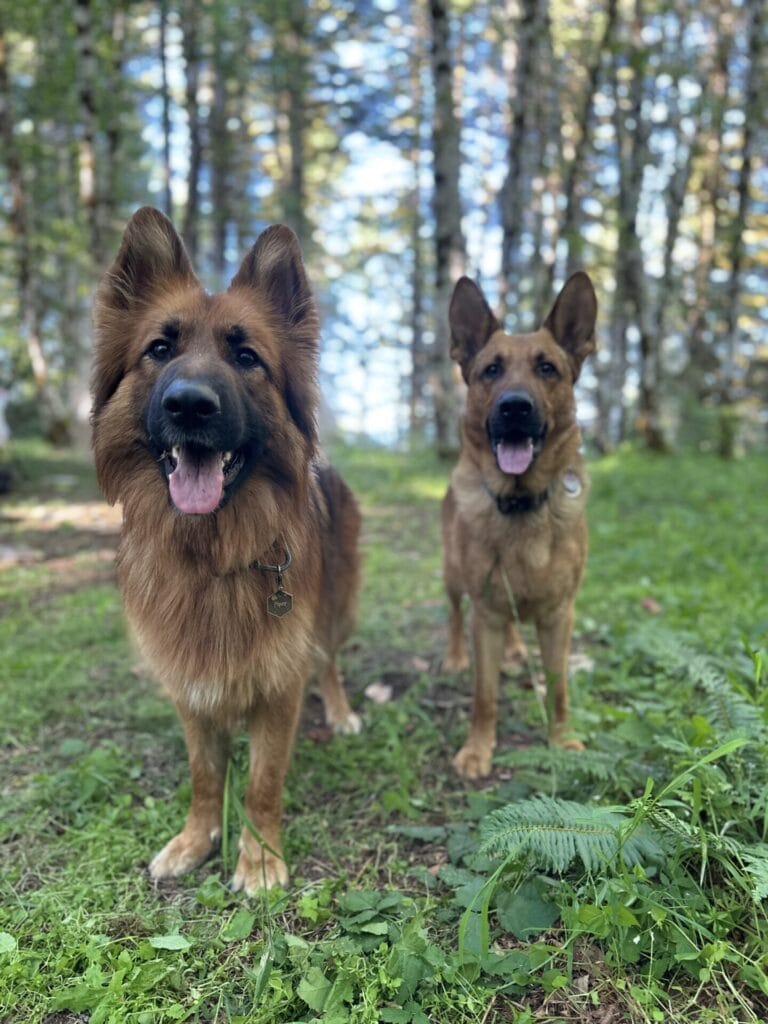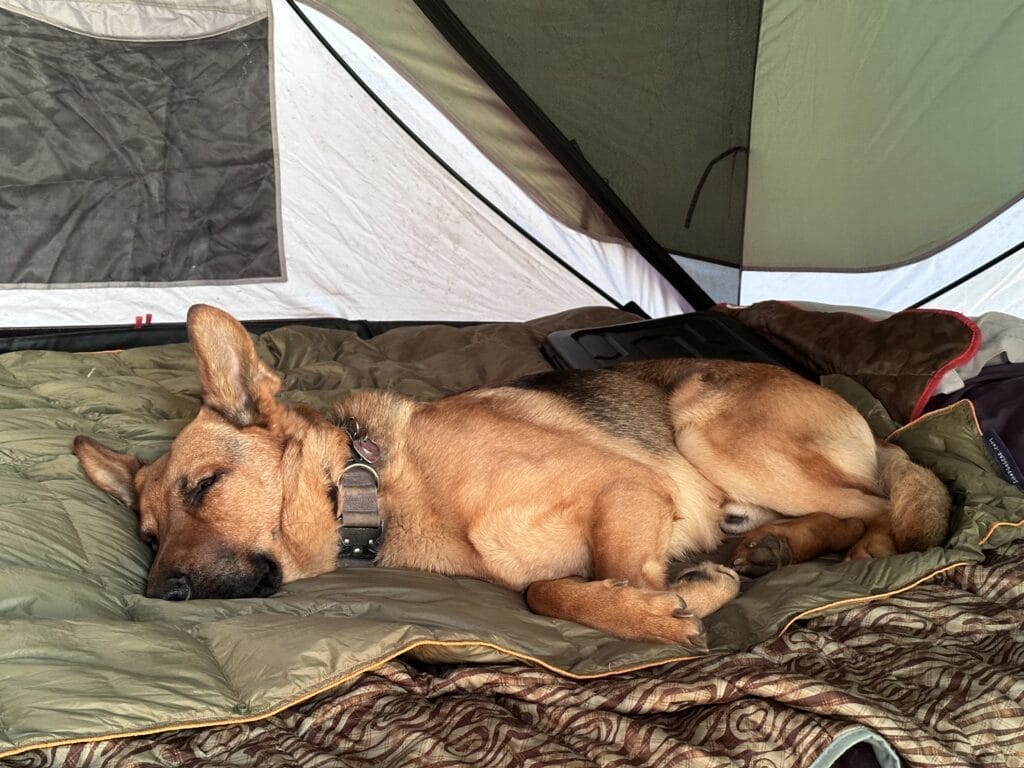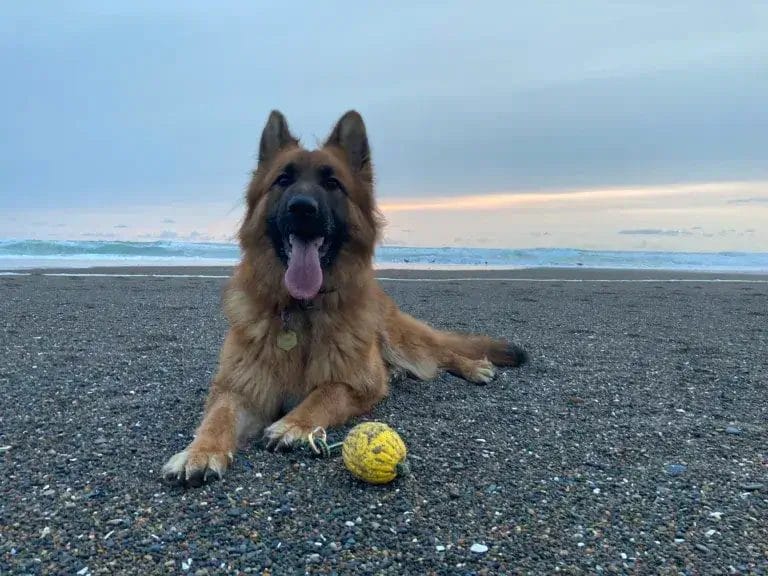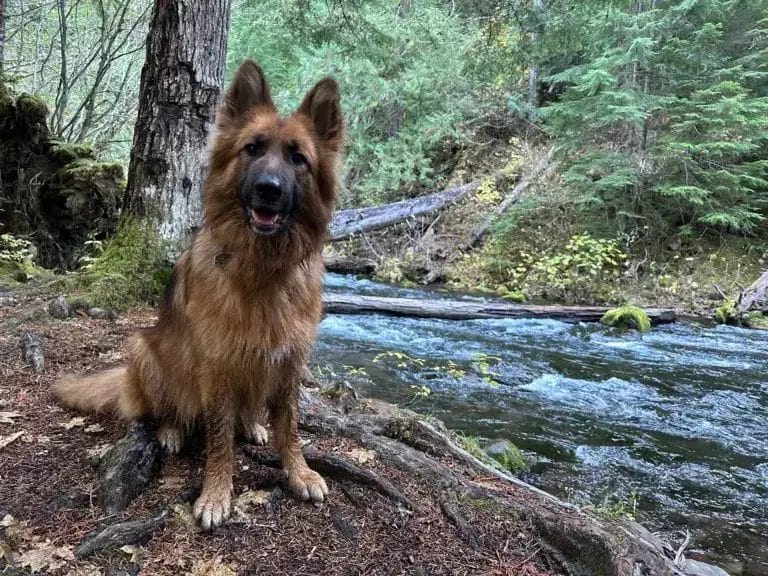Camping With Multiple Dogs – Tips and Tricks
Exploring the outdoors with our four-legged family members creates memories that stick with us. When you camp with more than one dog, there’s an extra layer of joy and, honestly, a few extra challenges that make every trip unique.
We’ve been camping with our two German Shepherds for years. People often ask us for tips on how we make it work.

Preparation is everything when camping with multiple dogs. That means picking pet-friendly campgrounds, packing the right stuff, and figuring out a setup that keeps your dogs safe and comfy.
This covers things like special tent arrangements or a secure picket line system so your pups have some freedom but stay safe.
One of the best things about camping with several dogs? They keep each other entertained. Ours are always more relaxed and less bored during car rides when they’ve got a buddy along.
Watching your pack explore new trails, get excited over wildlife scents, and curl up by the fire, those are the moments that make it all worthwhile.
Key Takeaways
- Pack extra supplies and set up a dedicated space at camp so each dog feels secure and comfortable.
- A picket line system gives your dogs freedom to move around while keeping them safe at camp.
- Get your dogs used to exercise and outdoor socializing before your trip for a smoother camping experience.
Preparing for Your Camping Adventure

Taking your pack camping isn’t something you want to just wing. A little planning goes a long way toward making sure everyone has a safe, awesome time out in nature.
Choosing the Right Destination
When you’re camping with multiple dogs, location matters a lot! We’ve found that backcountry camping and dog-friendly campgrounds are the way to go for multi-dog families.
Many National Park Service sites and local parks welcome dogs, but always double-check their rules before heading out.
Look for campgrounds with:
- Spacious sites (at least 30 feet from your neighbors)
- Dog-friendly trails (this can be tricky, so check in advance!)
- Nearby water for play and drinking
- Natural boundaries to help keep your pack contained
Check dog policies before you book. Some places limit how many dogs you can bring or require leashes at all times. Breed or size restrictions might pop up, too.
If it’s your first time, pick a less crowded spot close to home. That way, if things get chaotic, you’ve got an easy exit plan.
Essential Camping Gear for Your Dogs
Your pups need their own gear just like you do! Upgrading your setup can make camping with a pack way easier.
Must-haves:
- Long stake-out lines or dog stake leashes (one for each dog) OR make a DIY Zip Line
- Sturdy harnesses and reflective collars with ID tags
- Food and water bowls – we prefer the collapsible ones to save space
- Comfy dog beds or mats – our dogs love their Helinox cots
- Dog first aid kit
For containing multiple dogs, pop-up exercise pens are a lifesaver (if you have smaller dogs). They’re light, easy to move, and make a safe boundary so your dogs can still enjoy the outdoors.
Bring along favorite toys, especially durable ones. We always pack a comfort item from home for each dog, it helps them settle in.
Packing the Essentials
Packing for several dogs can get messy if you’re not organized. We use a dedicated “dog pack” for all their stuff.
Food planning:
- Pack at least 20% more food than you think you’ll need – better to have too much than not enough
- Use waterproof, airtight containers
- Stick to their usual food, camping isn’t the time to try something new (think upset stomach…diarrhea)
- Bring treats for rewards and training
Dogs burn more calories when they’re camping and hiking, so plan for bigger appetites. For longer trips, lightweight, calorie-rich food keeps your pack weight down.
Bring plenty of water or make sure there’s a clean source where you’re going. Our dogs usually drink two or three times more than at home when we’re outside all day. Collapsible bowls are perfect for meals and water breaks.
And don’t forget poop bags. Bring more than you think you’ll need – trust me on that one.
Health and Safety Preparations
Safety always comes first when camping with your dogs. We like to book a vet visit before any big trip.
Pre-trip checklist:
- Make sure vaccinations are up to date
- Apply flea and tick prevention
- Update microchip info
- Ask your vet about any local health risks
Take clear photos of each dog before you leave, just in case. Save digital copies of their vaccination records and your vet’s number on your phone.
Practice recall commands with each dog one-on-one before trying group training. We’ve learned that training separately first helps everyone behave better when the excitement ramps up.
Pack a pet first aid kit that includes bandages, antiseptic wipes, tweezers, and any meds your dogs need. Know where the nearest emergency vet is, just in case.
Health and Safety Preparations

Safety comes first when camping with our dogs. If we’re going on an extended trip or to an unfamiliar area, we usually schedule a vet visit first.
Pre-trip vet checklist:
- Ensure vaccinations are current
- Get flea and tick prevention applied
- Confirm microchip information is updated
- Discuss any destination-specific health concerns
Take clear photos of each dog before your trip in case one gets lost. Save digital copies of vaccination records and vet contact information on your phone.
Practice recall commands with each dog individually before attempting group training. We’ve found that training dogs separately first builds the foundation for better behavior when they’re together in an exciting environment.
Pack a pet first aid kit with bandages, antiseptic wipes, tweezers for tick removal, and any medications your dogs might need. Know the location of the nearest emergency vet to your campsite.
Setting Up Camp with Your Canine Companions
Creating a comfortable camp for multiple dogs takes a bit of planning and the right gear. Over the years, we’ve realized that preparation is what keeps everyone happy and stress-free.
Camping Tent and Sleep Arrangements
Tent size matters when you’re camping with a pack! We always recommend going bigger than you think you’ll need.
We love our Gazelle for two humans and our two dogs. It gives everyone room to sprawl out without stepping on tails.
Bring individual dog beds or mats that smell like home. That little touch of familiarity helps our pups settle in faster. If your dog is crate-trained, a collapsible crate can make them feel safe and prevent midnight wandering.
Watch the temperature. On chilly nights, we bring extra blankets just for the dogs. When it’s hot, cooling mats and good tent ventilation make a big difference.
To save your tent floor from claws, lay down a tarp or extra blanket. It’s a small step, but it’s saved our tent more than once!
Establishing a Routine and Safe Space
Dogs love routine, even when you’re out in the wild. We try to stick to the same feeding and walking times as at home to keep things calm and avoid restlessness.
Set up a designated area for your dogs at camp. We set up our own zip line for our dogs. That gives them space to roam but keeps them safe.
Pack familiar toys and comfort items. Our dogs’ favorite chews and puzzle toys work wonders for keeping them busy during downtime.
A raised dog cot under the awning or in the shade gives your pups a comfy spot off the ground. It keeps them away from dampness and bugs, and they quickly learn it’s their spot.
Managing Food and Hydration
Keeping your dogs hydrated is critical. We bring collapsible water bowls and scatter them around camp, refilling often, especially after playtime.
We portion our dogs’ food into zip-lock bags for each meal. This keeps things organized and helps prevent overfeeding. For longer trips, airtight containers keep kibble fresh and safe from critters.
Treats are a must! Our dogs burn a ton of energy outdoors, so we pack high-protein treats and long-lasting chews like bully sticks. They’re perfect for keeping the crew busy while we set up camp or cook.
We always stash all dog food with our own food in secure containers away from the tent at night. No one wants a raccoon party at 2 a.m. Or a bear for that matter.
Activities and Training

Camping with a pack opens up so many chances for fun, but it does take more planning and training. The right activities keep your pups happy, and a little prep keeps everyone safe.
Fun Camping Activities for Your Dogs
Dogs love exploring, and camping is full of new sights and smells. We’ve found hiking trails are perfect for burning off energy and bonding with your crew.
Bring plenty of water and take breaks in the shade. If you’re near water, swimming is always a hit. Rivers and beaches become playgrounds, but keep an eye on currents and always supervise.
Scent games are awesome for downtime. Hide treats around camp and let each dog hunt for them. It’s a great mental exercise and keeps them busy.
Evenings by the fire are special. We bring our dogs’ favorite blankets and let them chill with us under the stars. Some pet-friendly campgrounds even have dog socials, worth checking out if you want to make some new friends!
Training Multiple Dogs for Camping
Training matters before you head out with a pack of dogs. We start with basic obedience at home, making sure each pup listens to “sit,” “stay,” and “come.”
We practice these commands in more distracting places as the trip gets closer. It takes patience, but it pays off and it’s worth putting in the effort.
Leash training needs some extra focus. We like a hands-free setup for hiking with several dogs.
A belt-style leash system keeps your hands free and still lets you control the group. It makes a big difference on the trail.
For campsite management, try the tree-to-tree rope system. String a long rope between trees and clip your dogs’ leashes to it.
This gives them space to sniff around camp, but they can’t wander off. It’s a simple fix for a potentially chaotic situation.
Practice tent etiquette before you leave. Set up your tent at home and train your dogs to enter calmly, then settle down.
This keeps things from getting wild at bedtime. Trust me, it’s worth the effort.
Work on recall in open spaces, too. A solid recall can save the day if a dog slips free, and it’s crucial for safety while camping.
Safety and Etiquette in the Great Outdoors
Bringing dogs camping means paying extra attention to safety and etiquette. After plenty of adventures, I’d say preparation and respect for nature are non-negotiable with multiple dogs.
Navigating Through Different Terrains
Hiking with several dogs means looking out for all kinds of terrain. Rocky paths can be rough on paws, so we always pack dog booties for sharp or jagged ground. They can save you a vet visit!
Muddy or wet spots are slippery, so we keep leashes short when crossing streams or slick slopes.
This way, we have better control, and everyone stays upright. Forests bring their own set of problems, fallen branches, thick undergrowth, and the occasional thorny bush.
We keep our eyes peeled for hazards and use leashes under six feet in dense areas. That keeps the dogs close and out of trouble.
Hot sand or pavement in summer? We test surfaces with our hands. If it’s too hot for us, it’s too hot for their paws.
Campsite and Trail Rules and Regulations
We always check pet policies before we go anywhere. Some parks require leashes at all times, while a few allow supervised off-leash fun in certain spots.
Quiet hours count for dogs, too. We bring their favorite toys and beds so they can chill out when it’s time to wind down.
More exercise during the day means less barking at night. That’s the goal!
Poop bags are a must. We pick up after every dog and toss the waste in the right bins.
Some trails don’t allow dogs, especially in wildlife areas or during nesting season. We respect those rules and find another way if needed.
Many campgrounds limit how many dogs you can bring. We always call ahead to make sure our whole crew is welcome.
Dealing with Emergencies
We never head out without a solid dog first aid kit. Ours has:
- Bandages and gauze for cuts
- Tweezers for ticks or splinters
- Hydrogen peroxide to clean wounds
- Antibiotic ointment to fight infection
- Dog-safe pain meds (from our vet)
- Eye wash for dirt or debris
We watch for signs of overheating, look for heavy panting, drooling, dry gums, vomiting, or diarrhea. If we see any of these, we get the dogs into the shade and cool them down with water.
Before we leave, we look up the nearest emergency vet and save their info. Cell service can be spotty, so we download offline maps with vet locations, just in case.
Respecting Wildlife and the Environment
With several dogs, we follow “leave no trace” even more strictly. We use a dog stake leash at camp and keep the dogs close on trails to prevent chasing wildlife.
Early mornings and dusk? That’s when wildlife gets active. We stay extra alert and keep the dogs nearby.
Barking can bother both wildlife and other campers. We’ve trained our dogs to quiet down on command, and we bring puzzle toys, chews, and balls to keep them busy at camp.
We never let our dogs swim in tiny ponds or fragile streams. Instead, we look for dog-friendly lakes or rivers where they can splash safely.
Wrapping Up Your Camping Trip
Wrapping up a camping trip with multiple dogs takes a bit of effort. Cleanup, checking on your pups’ health, and, maybe most important, taking a second to appreciate all those goofy, muddy, happy moments you shared.
Cleaning Up and Leaving No Trace
We always try to leave our campsite better than we found it, especially with a bunch of dogs along. Start by walking the site and picking up any stray toys, leashes, or gear.
Double-check for dog waste. We always bring extra poop bags for the last round of cleanup.
Leaving dog waste behind is the fastest way to ruin a beautiful spot, and it’s bad for wildlife, too. Pack out all your trash, including food wrappers and cans.
Shake out dog beds and blankets away from camp to get rid of hair and dirt before you pack them up. Before you leave, do one last walk around to make sure you haven’t missed anything.
That’s how we keep outdoor spaces open and welcoming for everyone who loves camping with dogs. Leaving a mess behind could jeopardize pet friendly camping for everyone and that’s not ok.
Post-Camping Grooming and Health Check
Once we’re home, we always check over every dog and get them cleaned up. Start with a full body check, look for ticks, cuts, scrapes, or any weird bumps.
Check between their paw pads for thorns, burrs, foxtails or little rocks. If you find anything, get it out right away. A warm bath helps with any dirt, pollen, or lingering “campfire” smells they picked up.
Brush out their coats to catch tangles and spot hidden problems. This is especially important for long-haired pups or those who dove headfirst into the woods.
If you spot anything odd during your check, jot it down for your next vet visit. We update our dogs’ health records with anything we notice after a trip.
Don’t forget to reapply flea and tick meds if you’ve been in thick brush or grassy spots!
Reflecting on the Experience with Your Dogs
Take a little time to think about what went well and what you’d change next time. Did all your pups have fun? Were there activities that got them especially excited?
We like to make a quick photo album or jot down a few notes about each trip. Those snapshots, like your dog’s first swim or the time they discovered a squirrel, are memories worth keeping.
Consider which gear worked and what needs an upgrade. Maybe that long leash was perfect, or maybe you need a better sleeping setup for next time.
Every trip teaches us something new about camping with our dogs. It’s a bonding experience, and you learn a lot about who they are away from home.
I swear, after a camping trip, our dogs always seem more tuned in and happy. There’s just something about exploring nature together that brings out the best in everyone.
And the more we take them along on camping trips, the easier it gets
Frequently Asked Questions

Camping with a whole crew of dogs brings up a lot of questions if you’ve never done it before. Here are the ones we get asked the most about prepping, logistics, and keeping everyone safe when you’re out in the wild.
What are the best ways to manage leashes and space for multiple dogs while tent camping?
Managing a bunch of dogs at camp can get tricky, but it’s doable! We like stake-out lines or tie-outs that give each dog their own area near the tent.
This keeps leashes from tangling and still follows campground rules. Inside the tent, we set up separate sleeping spots for each pup with their own blankets or beds.
That way, there’s less drama over who gets the best spot. Teaching solid leash manners and recall before you go makes a huge difference.
We always run through those basics in the backyard before heading out.
How can you prepare your pups for their first-ever camping adventure together?
Start with a short trip close to home. That way, if things go sideways, you can pack up and head back easily.
We bring familiar stuff like beds, toys, and food bowls to help the dogs feel at home in a new place. Practice sleeping in the tent together in your backyard first. It gets everyone used to the sounds and close quarters before you’re out in the wild.
Make sure your dogs are up-to-date on shots and flea/tick meds. We also pack recent photos of each dog, just in case someone pulls a Houdini and wanders off.
Can you offer tips for choosing dog-friendly campsites that accommodate more than one pet?
Always check campground regulations before booking. Some places limit the number of pets per site, so don’t just trust the website; call ahead and ask about their multi-dog policies.
Look for campsites with enough space between neighbors. More distance means your dogs are less likely to get riled up by nearby campers or other dogs.
We like sites with natural barriers like trees, bushes, that sort of thing. These visual breaks help our dogs chill out instead of reacting to every little movement around the campground.
What essential items should you not forget when going RV camping with your furry friends?
When we hit the road in the RV, we always bring plenty of water and collapsible bowls for each dog. Some campgrounds barely have fresh water, so a portable water container is a must.
We pack a first aid kit just for the dogs. Ours have their meds, some bandages, tweezers for ticks, and styptic powder for those inevitable torn nails. Keeping human and pet supplies separate saves a lot of hassle later.
Extra towels are a lifesaver for muddy paws, trust me, you don’t want that mess in the RV. Wiping them down before they come inside keeps things way more comfortable for everyone.
Any advice on making nighttime cozy and safe for our canine companions when outdoors?
We always bring separate sleeping pads or beds for each dog. It keeps our own sleeping gear safe from claws, and the pups seem to sleep better with their own blankets.
Light-up or reflective collars make nighttime potty breaks way less stressful. It’s a relief to know exactly where each dog is, even in pitch darkness.
Nighttime temps can drop fast, even in summer. We usually toss in a few extra blankets since some dogs, especially the short-haired ones, get cold as soon as the sun goes down.
What should you do if you need to momentarily leave your dogs unattended at the campsite?
Try not to leave your dogs alone at all, honestly. We usually take turns shopping or showering, so at least one of us hangs back with the pups.
If you absolutely have to step away, secure them with a safe tie-out or keep them inside the RV. Just don’t leave them loose, even for a minute.
Give them shade and plenty of water, and double-check the weather before you go. I always worry about sudden storms or heat, so it’s worth a quick look at the forecast.
Leave a favorite toy or treat puzzle behind to keep them busy. It can help ease their nerves and hopefully prevent barking or any wild escape plans while you’re gone.








